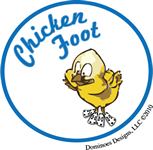The History of Dominoes
(The following is an excerpt from "Wickipedia." We encourage you to click here for a very interesting, comprehensive, and indepth coverage of Dominoes.)
Dominoes (or dominos) generally refers to the collective gaming pieces making up a domino set (sometimes called a deck or pack) or to the subcategory of tile games played with domino pieces. In
the area of mathematical tilings and polyominoes, the word domino often refers to any rectangle formed from joining two congruent squares edge to edge.
The traditional Sino-European domino set consists of 28 dominoes, colloquially nicknamed bones, cards, tiles, tickets, stones, or spinners. Each domino is a rectangular tile with a line dividing its face
into two square ends. Each end is marked with a number of spots (also called pips) or is blank. The backs of the dominoes in a set are indistinguishable, either blank or having some common design.
A domino set is a generic gaming device, similar to playing cards or dice, in that a variety of games can be played with a set.
Domino pieces were historically carved from ivory or animal bone with small, round pips of inset ebony. The game's name comes from the pieces' resemblance to Venetian Carnival masks known as
domini, which were white with black spots. These masks were so named, in turn, because they resembled French priests' winter hoods, being black on the outside and white on the inside. The
name ultimately derives from the Latin dominus, meaning "lord" or "master."
The oldest domino sets have been dated from around 1120 A.D. Modern dominoes, as most of the Western world knows them, however, appear to be a Chinese invention. They were apparently
derived from cubic dice, which had been introduced into China from India some time in the distant
past. Each domino originally represented one of the 21 results of throwing two dice. One half of each
domino is set with the pips from one die and the other half contains the pips from the second die.
Chinese sets also introduce duplicates of some throws and divide the dominoes into two classes:
military and civil. Chinese dominoes are also longer than typical European dominoes. Over time
Chinese dominoes also evolved into the tile set used to play Mah Jong, a game which swept across
the United States in the early to mid 1920s and has enjoyed moderate popularity, especially in its "solitaire" form, since that time.
The early 18th century witnessed dominoes making their way to Europe, making their first
appearance in Italy. The game changed somewhat in the translation from Chinese to the European
culture. European domino sets contain neither class distinctions nor the duplicates that went with
them. Instead, European sets contain seven additional dominoes, with six of these representing the
values that result from throwing a single die with the other half of the tile left blank, and the seventh
domino representing the blank-blank (0-0) combination.
Ivory Dominoes were routinely used in 19th century rural England in the settling of disputes over
traditional grazing boundaries, and were commonly referred to as "bonesticks" (see Hartley, Land
Law in West Lancashire in the mid- 19th Century, Farm Gazette, March 1984).



Search Our Website
This is the descriptive text in the popup
Website Login
This is the descriptive text in the popup